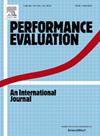The Multiserver Job Queuing Model with two job classes and Cox-2 service times
IF 0.8
4区 计算机科学
Q4 COMPUTER SCIENCE, HARDWARE & ARCHITECTURE
引用次数: 0
Abstract
Datacenters comprise a variety of resources (processors, memory, input/output modules, etc.) that are shared among requests for the execution of computing jobs submitted by datacenter users. Jobs differ in their frequency of arrivals, demand for resources, and execution times. Resource sharing generates contention, especially in heavily loaded systems, that must therefore implement effective scheduling policies for incoming jobs. The First-In First-Out (FIFO) policy is often used for batch jobs, but may produce under-utilization of resources, in terms of wasted servers. This is due to the fact that a job that requires many resources can block jobs arriving later that could be served because they require fewer resources. The mathematical construct often used to study this problem is the Multiserver Job Queuing Model (MJQM), where servers represent resources which are requested and used by jobs in different quantities. Unfortunately, very few explicit results are known for the MJQM, especially at realistic system loads (i.e., before saturation), and hardly any considers the case of non-exponential service time distributions. In this paper, we propose the first exact analytical model of the non-saturated MJQM in case of two classes of customers with service times having 2-phase Coxian distribution. Our analysis is based on the matrix geometric method. Our results provide insight into datacenter dynamics, thus supporting the design of more complex schedulers, capable of improving performance and energy consumption within large datacenters.
具有两个作业类和Cox-2服务时间的多服务器作业队列模型
数据中心包含各种资源(处理器、内存、输入/输出模块等),这些资源在执行数据中心用户提交的计算作业的请求之间共享。作业的到达频率、资源需求和执行时间各不相同。资源共享会产生争用,特别是在负载沉重的系统中,因此必须为传入的作业实现有效的调度策略。先进先出(FIFO)策略通常用于批处理作业,但就浪费服务器而言,可能会导致资源利用率不足。这是因为需要大量资源的作业可能会阻塞稍后到达的作业,因为这些作业需要较少的资源。通常用于研究此问题的数学结构是多服务器作业排队模型(MJQM),其中服务器表示作业以不同数量请求和使用的资源。不幸的是,很少有关于MJQM的明确结果,特别是在实际系统负载下(即,在饱和之前),而且几乎没有考虑到非指数服务时间分布的情况。本文提出了两类服务时间具有两相协差分布的客户的非饱和MJQM的第一个精确解析模型。我们的分析是基于矩阵几何方法。我们的结果提供了对数据中心动态的洞察,从而支持更复杂的调度器的设计,能够提高大型数据中心的性能和能耗。
本文章由计算机程序翻译,如有差异,请以英文原文为准。
求助全文
约1分钟内获得全文
求助全文
来源期刊

Performance Evaluation
工程技术-计算机:理论方法
CiteScore
3.10
自引率
0.00%
发文量
20
审稿时长
24 days
期刊介绍:
Performance Evaluation functions as a leading journal in the area of modeling, measurement, and evaluation of performance aspects of computing and communication systems. As such, it aims to present a balanced and complete view of the entire Performance Evaluation profession. Hence, the journal is interested in papers that focus on one or more of the following dimensions:
-Define new performance evaluation tools, including measurement and monitoring tools as well as modeling and analytic techniques
-Provide new insights into the performance of computing and communication systems
-Introduce new application areas where performance evaluation tools can play an important role and creative new uses for performance evaluation tools.
More specifically, common application areas of interest include the performance of:
-Resource allocation and control methods and algorithms (e.g. routing and flow control in networks, bandwidth allocation, processor scheduling, memory management)
-System architecture, design and implementation
-Cognitive radio
-VANETs
-Social networks and media
-Energy efficient ICT
-Energy harvesting
-Data centers
-Data centric networks
-System reliability
-System tuning and capacity planning
-Wireless and sensor networks
-Autonomic and self-organizing systems
-Embedded systems
-Network science
 求助内容:
求助内容: 应助结果提醒方式:
应助结果提醒方式:


